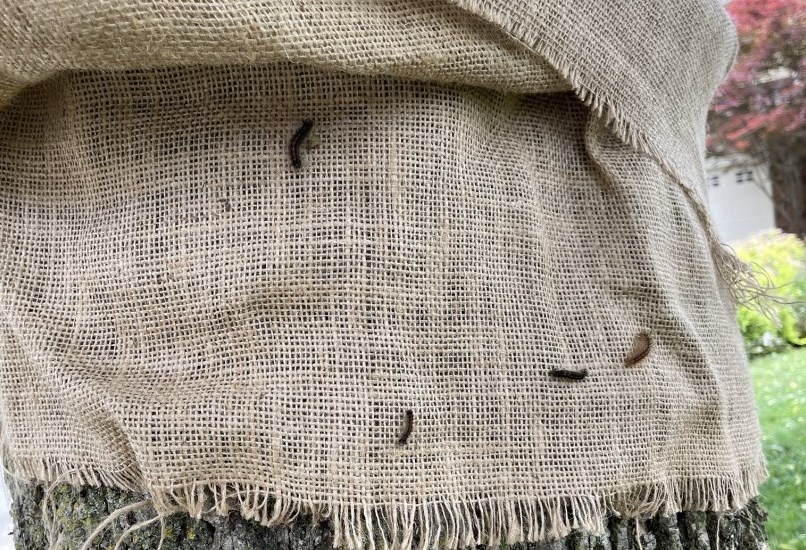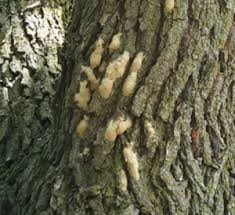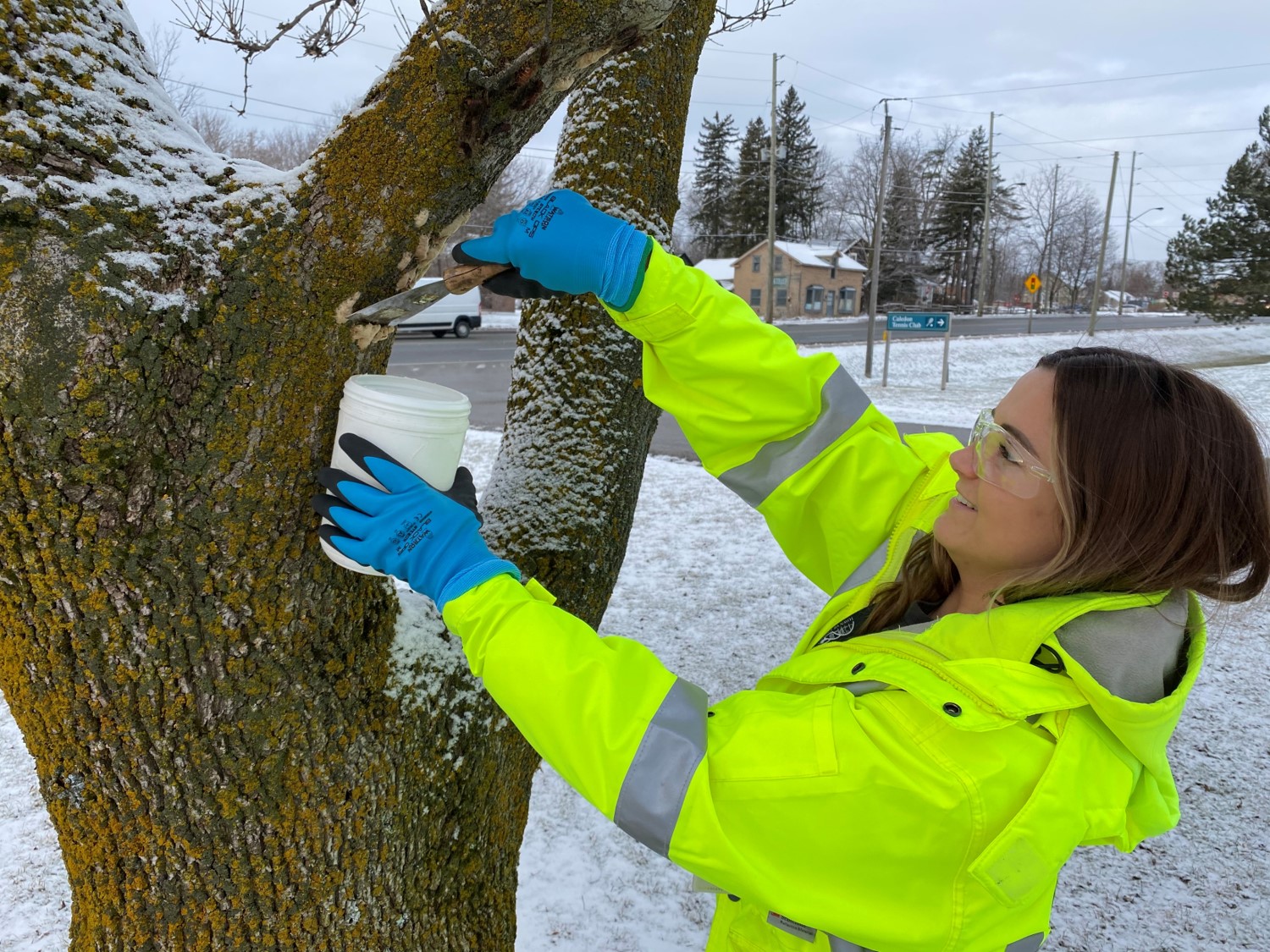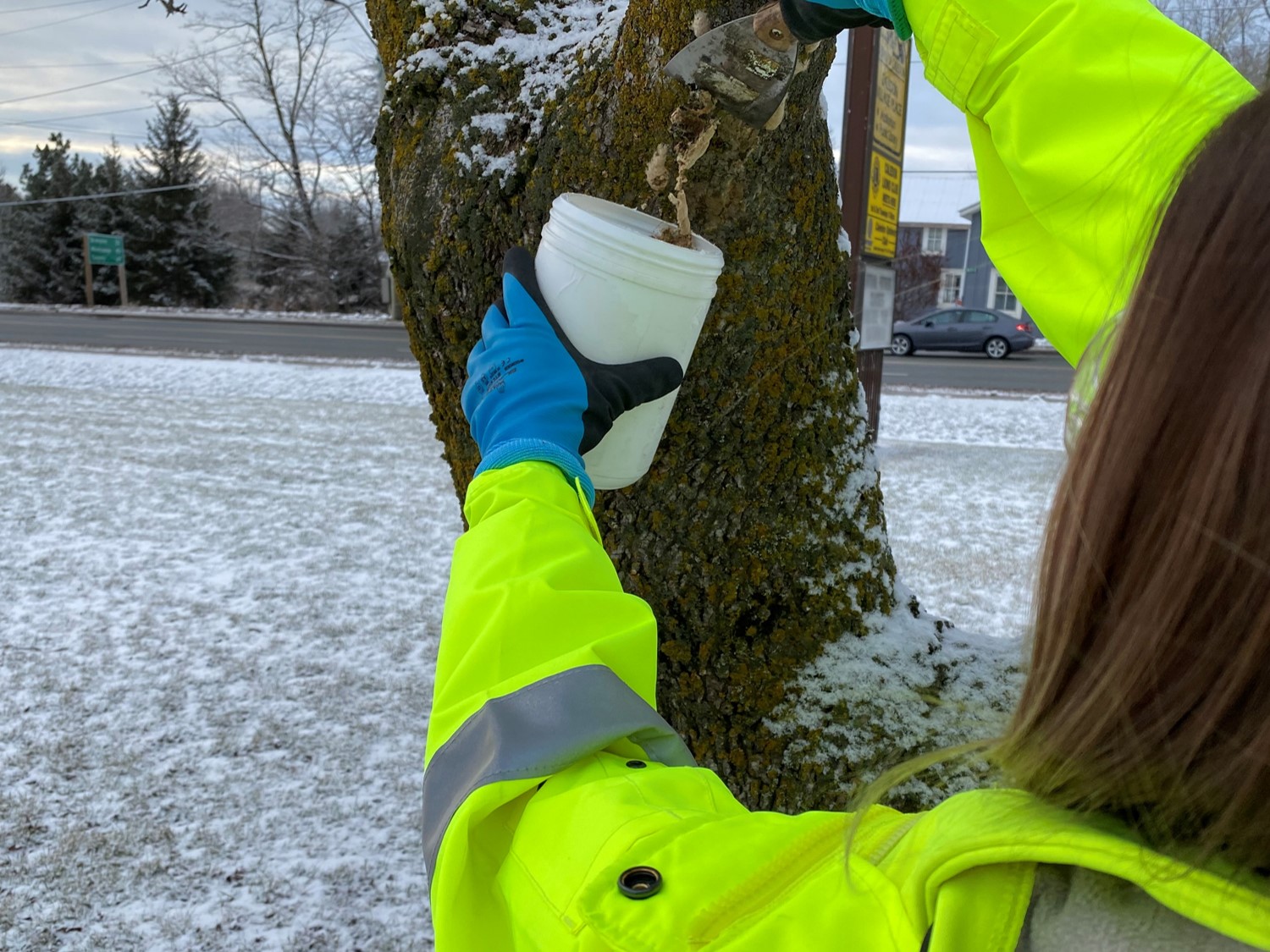
NOTE: In March 2022, the Entomological Society of America (ESA) announced “spongy moth” as the new common name for the moth Lymantria dispar dispar (LDD). The new name refers to the insect’s distinctive sponge-like egg masses and is derived from translations of common names used for the insect in its native range and French-speaking Canada. The Town of Caledon will be transitioning to “spongy moth” as time and resources allow.
Overview
| What is the spongy moth? |
|
The spongy moth is an invasive moth species from Europe that has established in southern Canada, as well as the eastern and central United States. It is a forest pest of concern because of the ability of the moth’s larvae (caterpillars) to defoliate trees (consume leaves). Healthy trees can typically survive severe defoliation by the spongy moth larvae; however, repeated defoliation stresses trees and makes them more vulnerable to other forests pests, diseases and drought.
Though the spongy moth accepts many tree species as its host, some of the more-preferred hosts include oak, maple, alder, beech, and birch species. Defoliation from larva feeding on leaves typically stops in early summer when the caterpillars have entered the pupae (cocoon) phase for one-to-two weeks.
Male and female adult moths then hatch from pupae around mid-July, but do not feed on the leaves of the trees. Instead, the adult moths spend their short-lived lives reproducing and laying egg masses to restart the life cycle.
Spongy moth population outbreaks occur in cycles, so while there may be an aggressive infestation one year, it does not mean it will continue year after year.
|
| Learn more about the spongy moth |
|
Learn more about the spongy moth’s life cycle and impacts:
NOTE: Some of the resources may address the species as "LDD moth".
|
2023 Spongy Moth Updates
Results of summer 2022 defoliation (leaf consumption) surveys and fall 2022 egg mass monitoring efforts suggest that the 2023 spongy moth population and impacts in the Town of Caledon will be minimal. A combination of successful management in 2022 and biological characteristics of the spongy moth population cycles suggests widespread management by the Town will not be required in 2023.
The Town will continue to monitor localized areas with high occurrences of spongy moth throughout 2023 and manage on a as needed basis. Management options used in 2022 will be applied as necessary.
What can residents do?
Together, we can continue to monitor and manage the spongy moth in Caledon. Here's what you can do as a resident:
Inform us about spongy moth on Town property
If the spongy moth is seen on Town property, please contact Service Caledon at 3-1-1, email info@caledon.ca. It will be investigated by the Town Invasive Species Coordinator or Arborist. Or you can report a sighting to our Spongy Moth Tracking Form (see below).
Report spongy moth on public and private property
Report spongy moth during its various life stages on public and private properties throughout the Town!
Your efforts will help increase spongy moth monitoring data used by the Town to inform management decisions for the invasive moth across the municipality.
Submit a report using our tracker form:
Spongy Moth Tracking Form
Check out other reports on the interactive Spongy Moth Tracking Map:
Spongy Moth Tracking Map
Please note: Using the reporting tool will not initiate a inspection by the Town Invasive Species Coordinator or Arborist. Please contact Service Caledon at 3-1-1 or email info@caledon.ca to request a inspection.
You can also report spongy moth sightings (on public or private properties) by:
Manage spongy moth on private property
The Town does not provide service to private properties. For effective management, property owners need to consult with their chosen tree care professional to determine the best way to manage trees on their own property. See How and when do I protect trees on my property? in the Frequently Asked Questions for management options for landowners.
How to manage spongy moth on your property
Frequently asked questions
| What is the spongy moth? |
| The spongy moth is a major forest pest in North America. In the larval (caterpillar) stage, the insect eats the leaves of trees making host trees more susceptible to disease and damage from other insects. Large infestations of caterpillars also pose a threat to people due to the large amount of frass (caterpillar droppings) produced, and hairs found on the larvae and pupae (cocoons) can cause skin irritation and allergic reactions. |
| How much damage can the spongy moth cause to trees? |
| Depending on the level of infestation, damage can range from light to almost complete defoliation or loss of leaves. Healthy trees can typically survive severe defoliation by the spongy moth caterpillars; however, repeated defoliation stresses trees and makes them more vulnerable to other forest pests, diseases and drought. In some situations, if the tree has been weakened or stressed by other conditions, the trees health will decline. |
| What kinds of trees are most affected by the spongy moth caterpillar? |
| Over 300 plant species have been known to host the spongy moth, and 150 are considered “favoured hosts” (Invasive Species Centre, 2022). Spongy moths prefer oak trees but will eat all kinds of hardwoods including alder, beech, birch, linden, maple, and poplar species. Less-favoured host species include: ash species, sycamore, butternut, black walnut, dogwood or balsam fir. |
| What is the lifecycle of the spongy moth? |
|
Like other Lepidopteran species (moth and butterfly species), the spongy moth has an egg, larval, pupal, and adult life stage.
Eggs are protected by a golden brown or yellow fuzz, in the form of an egg mass. One egg mass can host between 600 and 1000 spongy moth eggs. Egg masses stay dormant all winter and hatch the following spring during late April to mid-May.
Larvae (caterpillars) hatch from the egg mass and climb up to feed on the foliage (leaves) of the host tree. When larva hatch they are about 0.5 cm long and are very dark in colour. Over time (one to two months) the larva will continue to feed and grow up to 6-7 cm in length, and are identified by the five pairs of blue dots and six pairs of red dots along their backs.
CAUTION: spongy moth larvae contain hairs that can cause skin irritation or allergic reactions.
Pupae (cocoons) are formed by the larvae once they have matured (after about seven weeks of feeding). This one to two-week phase is how/when a larva transitions to an adult moth. When the adult moth emerges, the shell of the pupae is left behind. Female spongy moth pupae are often larger than the males, and are also larger than the males when in the adult stage.
CAUTION: spongy moth pupae also contain hairs that can cause skin irritation or allergic reactions.
Adults (moths) are short-lived and seen in mid-summer. Both genders die after the (flightless) female lays a single egg mass on the limbs and/or trunk of the host trees. Egg masses can also be laid on surrounding rocks, buildings, or in other sheltered areas. Male moths are brown in colour, and females are white with dark markings (and larger in size). The moths do not feed on the host tree, they only reproduce.
|
| Are there any natural predators to the spongy moth? |
|
Yes. Natural predators include parasitic wasps, beetles, and mice. When caterpillars first hatch, birds such as chickadees, blue jays, robins and nuthatches may prey on them. Young caterpillars contain fewer irritating hairs than adult caterpillars, making younger larva easier for animals to eat. Spongy moth populations are also reduced by diseases caused by fungi and viruses.
|
| How and when do I protect trees on my property? |
|
Depending on location and seasonal conditions, timing for managing infestation may overlap. These methods are also intended for individual trees and not large-scale woodlot management.
| Year round |
| Property owners can do their part in protecting their trees from the spongy moth, and other stressors, year-round by keeping their trees healthy. This includes watering trees during dry seasons and protecting tree roots. Avoid crowding tree root areas with heavy stones or by piling large amounts of soil at the base of the tree. This will help ensure the roots of the tree are getting the appropriate amount of water. |
| January to April |
Egg mass removal
- Scrape egg masses off the tree (or other surface) into a water/soap mixture.
- Do not scrape egg masses onto the ground- they will still be able to hatch.
TIP: Spraying the egg mass with water before scraping will prevent it from crumbling and falling onto the ground before capturing it.
- Let the egg masses soak for a minimum of 48 hours. Stir the mixture occasionally to ensure complete coverage.
- Dispose of soaked egg masses into the garbage, and soapy water accordingly.
NOTE: Wear gloves when handling caterpillars and/or pupae since they contain hairs that can cause skin irritation or an allergic reaction.
|
| May to August |
Caterpillar and pupae removal
- Scrape off caterpillars into a water/soap mixture.
- Do not scrape caterpillars onto the ground- they will climb back up the tree/structure.
- Let the caterpillars soak for a minimum of 48 hours. Stir the mixture occasionally to ensure complete coverage.
- Dispose of caterpillars into the garbage, and soapy water accordingly.
TIP: If the caterpillars are not accessible or the infestation is severe on a tree, consider burlapping or sticky tree-banding the tree to make caterpillars more accessible for removal. Hand-removal of caterpillars is also easier and most effective when they are in more mature growth stages from mid-June to August (before pupae stage). Pupae can also be scraped and disposed of using the same method when they start to appear in mid-June to July.
NOTE: Wear gloves when handling caterpillars and/or pupae since they contain hairs that can cause skin irritation or an allergic reaction.
Burlapping and/or sticky barrier bands
In the heat of the day caterpillars will seek shelter by climbing down the trunk of the tree. By placing a burlap band or sticky barrier band around a tree, caterpillars will become trapped in an accessible location for removal.
Burlapping
Burlap bands can be installed in early May (or weather depending, when you see caterpillars start to crawl on the tree) and kept on until mid-August. As caterpillars feed and grow, they will become easier to find and hand-pick or scrape from the burlap band. Burlap can be purchased in the form of skirts or wrap at most hardware stores.
For instructions on how to install a burlap band, check out our how-to guide.
Remove the burlap band in late-August for re-use in future seasons. Ensure all spongy moth life stages (caterpillars, pupae, egg masses) on the burlap are removed and soaked in soapy water before reusing or disposal.
NOTE: Wear gloves when handling caterpillars and/or pupae since they contain hairs that can cause skin irritation or an allergic reaction.
Sticky barrier bands (sticky band traps)
Caterpillars can also be trapped with sticky barrier bands or sticky band traps. This approach is most effective in late April to late May when caterpillars are small and difficult to hand-pick. If choosing to use a sticky barrier band, a preferred option is one that has an additional protective barrier to the cover the sticky layer meant to capture the spongy moth caterpillars. This will limit the risk of capturing non-target caterpillar species or other wildlife. Sticky barrier band kits and/or sticky band traps are available at most hardware stores or garden centres.
When using a sticky barrier band it is important to:
- Always follow instructions provided on the product label.
- Monitor the band regularly to ensure the trap is working, or does not need to be replaced.
- Monitor the band to make sure other wildlife is not being trapped.
- Replace your band with a burlap band in late May when caterpillars are larger.
If hand-picking, burlapping, or sticky barrier banding is not a preferred management option, property owners should consult with their chosen tree care professional to determine the best way to manage trees on their property.
|
| Mid-April to June |
Chemical treatment with insecticide
Chemical treatments using a registered biological insecticide with the active ingredient Bacillus thuringiensis kurstaki (Btk) can be applied when larvae (caterpillars) are in their early growth stages and actively feeding. Spongy moth larva need to consume the Btk biopesticides by feeding on the leaves of a treated tree in order to be killed. Spraying caterpillars directly with a Btk product will not work. Though domestic biopesticides for the management of spongy moth are publicly available, it is strongly recommended that a commercially licensed applicator apply the pesticide. Property owners should consult with their chosen tree care professional to determine the best way to manage trees on their own property and should ensure that the tree care professional is a licensed exterminator/operator in Ontario.
Timelines for chemical treatment windows will vary on weather conditions and when spongy moth larvae hatch from the egg masses in spring of each year. Spraying Btk biopesticides will not allow effective control when the larvae are more mature and not feeding as often (mid-June to mid-July/August). Always follow instructions indicated on the label of the product you have purchased.
|
| July to August |
Pheromone traps (Moth control)
Pheromones released by adult female spongy moths are mimicked to confuse and/or attract the adult males into the trap. This limits and/or prevents adult male moths from mating with the females while also gaging infestation severity. Since only one gender of the adult moth can be trapped (female spongy moths cannot fly), pheromone traps are not the most effective management option. However, it may reduce adult male moth numbers at small scales.
Pheromone 'lure' traps can be found at home improvement, nature stores, or online.
Here's how to set up your trap:
- Open lure package and pin the lure to the inside of the jar lid. We recommend wearing gloves. If the pheromones in the lure get on your hands, moths will follow you everywhere.
- Fill the trap 1/8 full with water and add a couple of drops of dishwashing liquid. Change the water and soap periodically during the season. The dishwashing liquid will kill the spongy moths.
- Insert the hanger and screw the lid onto the trap.
- Hang the trap securely. Avoid areas where people will be bothered by the moths.
- Traps should be disposed of in the garbage once no longer in use.
Want to make your own trap? Here are additional resources to help guide you:
|
| Late-August to December (and until May of next year) |
|
Now that the spongy moth is in its egg mass stage of the life cycle (for the second time this year), egg mass scraping can re-commence.
Spongy moth egg mass removal:
- Scrape egg masses off the tree (or other surface) into a water/soap mixture.
- Do not scrape egg masses onto the ground- they will still be able to hatch because snow can insulate/protect the eggs.
TIP: Spraying the egg mass with water before scraping will prevent it from crumbling and falling onto the ground before capturing.
- Let the egg masses soak for a minimum of 48 hours. Stir the mixture occasionally to ensure complete coverage.
- Dispose of soaked egg masses into the garbage.
NOTE: Wear gloves when handling caterpillars and/or pupae since they contain hairs that can cause skin irritation or an allergic reaction.
|
|
| How do I find spongy moth eggs? |
|
Inspect your property for egg masses between mid-August and the end of April of the following year. Conducting two search and removal efforts (one in the fall and one again in early spring) will ensure that all accessible egg masses will be found and destroyed. It is easiest to spot egg masses when the leaves are off the trees and shrubs.
Start in one corner of your property and walk in a systematic manner making sure to look high and low, on all types of vegetation and structures. Spongy moths lay their egg masses just about anywhere; but they prefer sheltered locations. Be sure to look at all natural and unnatural structures such as the underside of branches or bark, the underside of patio furniture, on stacks of firewood, rocks, and fences. Inspect all surfaces of your house including windowsill, under eaves, around bird houses or mailboxes as well.

LDD egg mass removal:
- Scrape egg masses off the tree (or other surface) into a water/soap mixture.
- Do not scrape egg masses onto the ground- they will still be able to hatch.
- Let the egg masses soak for a minimum of 48 hours. Stir the mixture occasionally to ensure complete coverage.
- Dispose of soaked egg masses into the garbage, and soapy water accordingly.
NOTE: Wear gloves when handling caterpillars and/or pupae since they contain hairs that can cause skin irritation or an allergic reaction.


|







 Subscribe to this page
Subscribe to this page